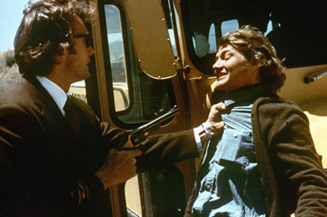|
|
Viking Night: Dirty HarryBy Bruce HallJune 22, 2010
It isn’t long before the most important aspect of any cat and mouse thriller is revealed – the fact that despite their disproportionate assets, the cat and the mouse are equally cunning! As an illustration of this, Harry foils an unrelated bank robbery after leaving the crime scene and famously asks the lone survivor how lucky he feels – you know the words. The moment is flashy but not necessarily superfluous; Harry and Scorpio are both strange people who tend to get what they want in violently abnormal ways, and as such have a unique ability to understand one another. Of course, this is the sort of thing that only happens in films – the Zodiac was never caught, and while the motivations of real serial killers are tragic and complex, Scorpio turns out to be motivated by far more ordinary things. And real detectives are considerably more astute than their movie counterparts; despite his knack for blowing things up Harry ultimately makes his collar as the result of dumb luck rather than brilliant police work. Most police dramas suffer from such things, but unlike most police dramas the tension driving Dirty Harry isn’t in the hunt for the killer, no doubt to the surprise of first time viewers. Callahan manages to track down Scorpio surprisingly early in the film, but the detective’s slash and burn methods have unintended consequences. Without meaning to, he raises the stakes and hands Scorpio a shocking victory. Suddenly, Harry is the one on the defensive, being raked across the coals over a legal technicality. It’s one of the most important scenes in the film and you shouldn’t overlook it because it’s really the meat of the action sandwich that is Dirty Harry. For one incredibly profound moment, the meanest man in San Francisco is the only one who has the empathy to question the welfare of Scorpio’s latest victim over that of her murderer. And when Callahan finally snarls back at his superiors “What about her rights?” you might feel as though he’s taken the words right out of your mouth. Eventually we discover that Harry wasn’t always this way – his wife was lost to a drunk driver, and his inability to fully cope is the source of his determination, as well as his charming personality.
|

|
|
|

|
Friday, November 1, 2024
© 2024 Box Office Prophets, a division of One Of Us, Inc.


